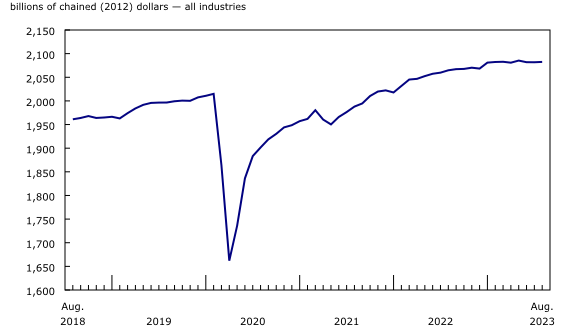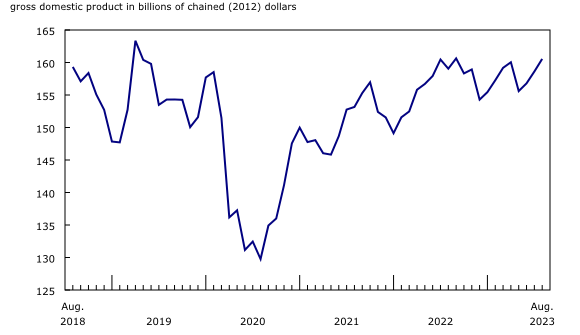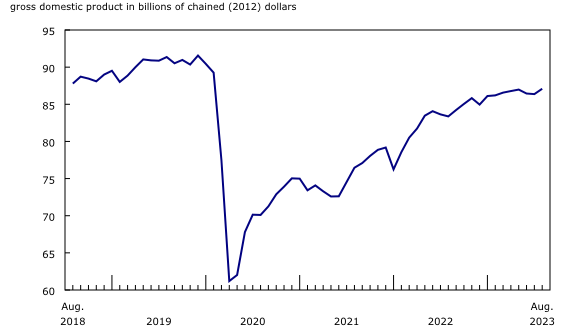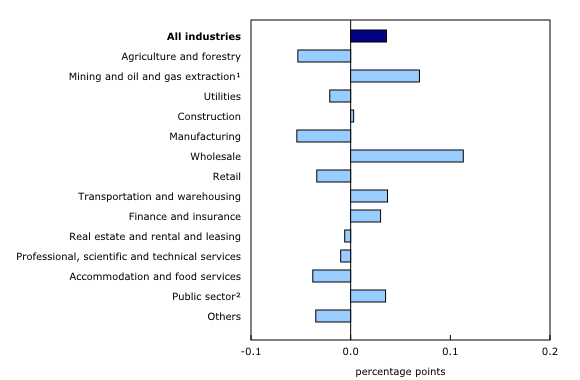Gross domestic product by industry, August 2023
Released: 2023-10-31
August 2023
0.0% 
(monthly change)
Real gross domestic product (GDP) was essentially unchanged for a second consecutive month in August as factors such as higher interest rates, inflation, forest fires and drought conditions continued to weigh on the economy. Services-producing industries edged up 0.1% in the month, while goods-producing industries contracted 0.2%. Overall, 8 of 20 industrial sectors increased.
Wholesale trade up for second month in a row
Wholesale trade (+2.3%) increased in August for the third time in four months, as six of nine subsectors contributed to the growth.
The machinery, equipment and supplies subsector led the growth with a 5.1% gain in August. This was the largest monthly growth rate since July 2020, coinciding with an increase in imports of industrial machinery, equipment, and parts. The miscellaneous product wholesaling subsector (+5.4%) further contributed to growth as higher wholesaling activity at agricultural supplies as well as recyclable material wholesalers drove the increase in the subsector.
Mining, quarrying, and oil and gas extraction expands for a third consecutive month
The mining, quarrying, and oil and gas extraction sector rose 1.2% in August. This third consecutive monthly increase brought activity above the April level, before activity fell in May due in part to the impact of the forest fires.
The oil and gas extraction subsector rose 1.0% in August, up for the seventh time in the last eight months, bringing activity to its highest level since April 2019. Oil and gas extraction (except oil sands) led the growth with a 1.3% expansion as both higher natural gas and higher crude oil extractions in Western Canada contributed to the increase. Gains in June, July and August more than offset the sharp decline in May attributed in large part to the impact of forest fires on natural gas extraction in Alberta.
Mining and quarrying (except oil and gas) increased 4.2% in August, led by an increase in copper, nickel, lead and zinc, which rebounded from a large decline in July that resulted in large part from maintenance activity.
Manufacturing contracts for third consecutive month
The manufacturing sector contracted 0.6% in August, as both non-durable goods and durable goods manufacturing contributed to the decrease for a third month in a row.
Partially offsetting declines was a gain in transportation equipment manufacturing, which posted its fourth increase in five months and continued the upward trend that began at the end of 2022 as issues related to semiconductor chip shortages continued to ease.
Accommodation and food services decline after July's gain
Accommodation and food services declined 1.8% in August, as both subsectors contracted. Food services and drinking places declined 2.2%, more than offsetting the 2.1% increase recorded in July. Accommodation services contracted 0.8% in August as a decline in traveller accommodation more than offset a gain in recreational vehicle (RV) parks, recreational camps, and rooming and boarding houses. Activities at RV parks, recreational camps, and rooming and boarding houses continued to be limited by the presence of wildfires in parts of the country and the industry has still not fully recovered after the declines recorded in May and June.
Transportation and warehousing grows in August
The transportation and warehousing sector increased 0.8% in August following two monthly declines, as 6 of 10 subsectors were up in the month.
Air transportation grew 3.7% in August, following declines in June and July that resulted from many flight delays and cancellations as many airlines faced bad weather conditions and technical issues.
Water transportation (+4.2% in August) fully recouped the declines recorded in July, when the port strike in British Columbia inhibited the transportation of certain goods, as exports and imports with countries other than the United States rebounded in August.
Rail transportation (+1.1% in August) was up for the second consecutive month. Intermodal carloadings were the main driver of the increase after the port strike inhibited movement of containers used in multiple modes of transportation. Wheat carloadings, which posted a large gain in July as wheat terminals remained open despite the port strike, recorded a decline in August, tempering growth in the subsector.
Transit, ground passenger and scenic and sightseeing transportation grew 2.6% in August, largely driven by increases in urban transit systems (+3.5%) due to an unseasonable increase in urban transit ridership.
Retail trade contracts for third month in a row
Retail trade contracted 0.7% in August, with 7 of 12 subsectors contributing to the monthly decrease, continuing the downward trend that started at the beginning of 2023. Motor vehicle and parts dealers (-2.6%) contributed the most to the decrease for a second consecutive month, with lower activity at new car dealers driving the decline in July and August.
Finance and insurance increases on market volatility
The finance and insurance sector grew for the third consecutive month, increasing 0.4% in August. Financial investment services, funds, and other financial vehicles (+2.6%) accounted for nearly all of the sector's growth as global economic and geopolitical factors contributed to market volatility in the month, increasing the amount of value and volume traded on financial markets in August.
Agriculture, forestry, fishing and hunting contracts
Agriculture, forestry, fishing and hunting contracted 3.2% in August, its largest decline since August 2021. Crop production (except cannabis) declined 6.7% in August 2023, in large part due to dry conditions in Western Canada, pushing down expected yields.
Advance estimate for real gross domestic product by industry for September and the third quarter of 2023
Advance information indicates that real GDP by industry was essentially unchanged in September. Decreases in mining, quarrying, and oil and gas extraction and utilities were partially offset by increases in the construction and public sectors. Owing to its preliminary nature, these estimates will be updated on November 30, 2023, with the release of the official GDP by industry data for September.
With this advance estimate for September, information on real GDP by industry suggests that the third quarter of 2023 was essentially unchanged. The official estimate for the third quarter will be available on November 30, 2023, when the official estimate of real GDP by income and expenditure is released.
Sustainable development goals
On January 1, 2016, the world officially began implementing the 2030 Agenda for Sustainable Development—the United Nations' transformative plan of action that addresses urgent global challenges over the following 15 years. The plan is based on 17 specific sustainable development goals.
The release on gross domestic product by industry is an example of how Statistics Canada supports monitoring the progress of global sustainable development goals. This release will be used to help measure the following goal:

Note to readers
Monthly data on gross domestic product (GDP) by industry at basic prices are chained volume estimates with 2012 as the reference year. This means that the data for each industry and each aggregate are obtained from a chained volume index multiplied by the industry's value added in 2012. The monthly data are benchmarked to annually chained Fisher volume indexes of GDP obtained from the constant-price supply and use tables (SUTs) up to the latest SUT year (2019).
For the period starting in January 2020, data are derived by chaining a fixed-weight Laspeyres volume index to the previous period. The fixed weights are 2019 industry prices.
This approach makes the monthly GDP by industry data more comparable with expenditure-based GDP data, which are chained quarterly.
All data in this release are seasonally adjusted. For information on seasonal adjustment, see Seasonally adjusted data – Frequently asked questions.
An advance estimate of industrial production for September 2023 is available upon request.
For more information on GDP, see the video "What is Gross Domestic Product (GDP)?."
Revisions
With this release of monthly GDP by industry, revisions have been made back to January 2022.
Each month, newly available administrative and survey data from various industries in the economy are integrated, resulting in statistical revisions. Updated and revised administrative data (including taxation statistics), new information provided by respondents to industry surveys, data confrontation and reconciliation process and standard changes to seasonal adjustment calculations are incorporated with each release.
Real-time table
Real-time table 36-10-0491-01 will be updated on November 6.
Next release
Data on GDP by industry for September will be released on November 30.
Products
The User Guide: Canadian System of Macroeconomic Accounts (13-606-G) is available.
The Methodological Guide: Canadian System of Macroeconomic Accounts (13-607-X) is also available.
The Economic accounts statistics portal, accessible from the Subjects module of the Statistics Canada website, features an up-to-date portrait of national and provincial economies and their structure.
Contact information
For more information, or to enquire about the concepts, methods or data quality of this release, contact us (toll-free 1-800-263-1136; 514-283-8300; infostats@statcan.gc.ca) or Media Relations (statcan.mediahotline-ligneinfomedias.statcan@statcan.gc.ca).
- Date modified:




